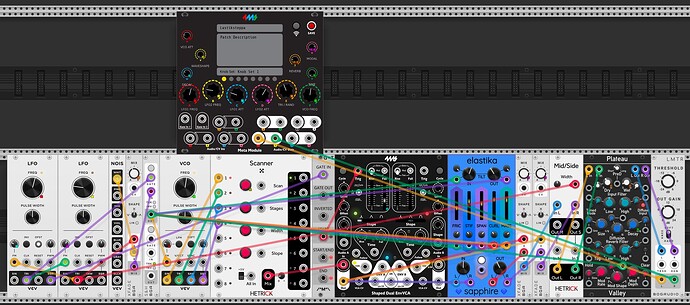External Audio Path:
-Main audio outputs on channel 1 and 2
Internal Audio Path:
-A VCO’s four main wave shapes are ran into a scanner which allows the user to crossfade between different wave shapes.
-The output of the crossfader goes into a shaped dual envelope VCA where a simple decay envelope is applied.
-The patch then runs into an Elastika Sapphire, where modal synthesis is applied.
-The output of the sapphire is ran through a dry/wet with the output of the VCO.
-The output of the crossfader then runs into a Mid/Side encoder/decoder to manipulate the stereo field.
-The output of the Mid/Side is fed into a valley plateau reverb
-The entire patch then goes through a limiter for volume protection.
Internal CV Path:
-Two triangle wave LFOs are cross modulated with one another and are processed by a sample and hold (LFO1 = clock, LFO2 = sample).
-Before LFO2 hits the sample and hold it is crossfed with white noise to allow random deviations of voltage to be sampled.
-The output of the S&H is used to control the pitch of VCO as well as scramble all of the parameters on the Elastika Sapphire.
MetaModule knob mappings:
A - LFO1 Frequency (clock)
B - LFO2 Frequency (sample)
C - LFO1 CV attenuverter
D - LFO2 CV attenuverter
E - Triangle/white noise crossfader for sample and hold
F - VCO main frequency
U - VCO attenuverter
V - Waveshape: crossfader for main waveshapes of VCO.
W - Decay time for main VCO pitch
X - Dry/Wet for Elastika.
Y - Reverb Dry/Wet
Z - Reverb decay time.
Lastiksteppa.yml (13.8 KB)
Lastiksteppa.vcv (3.9 KB)
